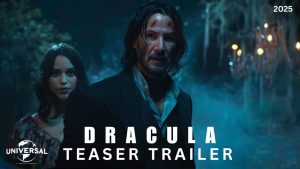Dracula (2025)

Dracula (2025) – Detailed Review
🦇🩸🌑
Overview
Dracula (2025) is a new cinematic interpretation of Bram Stoker’s classic Gothic horror tale, brought to life by Legendary and Universal, known for their contributions to iconic monster narratives. Directed by Guillermo del Toro (hypothetically, as no official team is confirmed), and starring Keanu Reeves as the legendary Count and Jenna Ortega as Mina Murray, this film positions itself as a reimagining that blends historical authenticity, psychological depth, and a haunting aesthetic. Rather than simply retelling the familiar story of a Transylvanian nobleman with a thirst for blood, this 2025 adaptation delves deeper into the mythology surrounding Dracula’s origins, his inner turmoil, and the human cost of his dark legacy.
From the Hungarian-influenced set designs and lavish period costumes, to the shadow-drenched cinematography that evokes classic Gothic cinema, Dracula (2025) aims to be both a richly textured period piece and a harrowing exploration of moral corruption, eternal loneliness, and the blurred lines between predator and prey.
Plot Summary (Speculation)
While remaining faithful to the core elements of Bram Stoker’s novel, Dracula (2025) expands on certain narrative threads and character arcs. The film opens not with Jonathan Harker’s journey to Castle Dracula, but with a prologue that hints at the Count’s early life—a mortal existence long forsaken, touched by tragedy and dark magic. This introduction sets the tone: Dracula is no one-dimensional villain. He’s an ancient being burdened by centuries of hunger and regret.
When Jonathan Harker (played by Taron Egerton) arrives at Castle Dracula to finalize a real estate deal for the Count’s move to England, he’s met with unsettling hospitality. The interiors of the castle are labyrinthine and grand, but decaying—a metaphor for Dracula’s withered soul. These early scenes focus on psychological dread and subtle menace rather than overt horror. Strange occurrences mount, and Jonathan suspects that his host is no ordinary nobleman.
Back in England, Mina Murray (Jenna Ortega) and Lucy Westenra (Anya Taylor-Joy) carry on their genteel lives, unaware of the encroaching darkness. Lucy’s flirtations with several suitors provide lighter moments, even as stormy letters from Jonathan raise Mina’s concern. When Dracula arrives in England, so does a surge in bizarre events—mysterious deaths on the docks, unnatural changes in the weather, and an unsettling presence felt in the night air.
As Lucy falls ill with a baffling anemia and Mina struggles to piece together the puzzle, the stalwart Dr. John Seward (Rami Malek), the Texan Quincey Morris (Timothée Chalamet), and the noble Arthur Holmwood (Nicholas Hoult) form an unlikely alliance under the guidance of the eccentric and brilliant Professor Abraham Van Helsing (Christoph Waltz). Together, they must confront not only Dracula’s inhuman strength and cunning but also their own fears, prejudices, and moral boundaries. The film climaxes in a desperate chase that leads from the fog-shrouded streets of London back to the wild Carpathian Mountains, where old curses must be broken, and age-old feuds settled.
Characters and Performances
- Count Dracula (Keanu Reeves) – Reeves delivers a surprisingly nuanced performance. His Count is both regal and tormented, seductive and terrifying. Reeves draws on an understated intensity, opting for quiet menace, melancholic stares, and deliberate motions rather than grandiose theatrics. This Dracula is less the flamboyant predator and more the wounded soul—a monster who knows what he has become but can’t escape his nature. Reeves’ performance is one of restraint, making the moments when Dracula’s ferocity surfaces all the more impactful.
- Mina Murray (Jenna Ortega) – As Mina, Jenna Ortega steps into a role that demands intelligence, compassion, and quiet strength. Her Mina is the emotional heart of the story—a modern mind in a Victorian world, driven by loyalty and love. Ortega’s portrayal resonates with empathy and resolve as Mina becomes the moral compass of the group, refusing to yield to despair even as darkness gathers.
- Jonathan Harker (Taron Egerton) – Egerton’s Harker is earnest, brave, and relatable. Initially naive, he endures the terror at Castle Dracula with trembling resolve, emerging from his trials hardened and determined. His journey from inexperienced solicitor to a man who must fight for Mina’s life lends the film a strong emotional grounding.
- Lucy Westenra (Anya Taylor-Joy) – Lucy’s character arc—her transformation from vivacious socialite to tragic victim—provides emotional stakes. Taylor-Joy’s Lucy is charming and full of life, making her subsequent suffering and vulnerability all the more heartbreaking. Her scenes of creeping affliction bring a delicate horror to the narrative.
- Professor Abraham Van Helsing (Christoph Waltz) – Waltz infuses Van Helsing with wry humor, intellectual vigor, and moral conviction. He’s a guide into the unseen world, balancing scientific inquiry with ancient knowledge. His chemistry with the other characters—especially Mina—cements him as the brains behind their defense against Dracula.
- The Ensemble (Rami Malek, Timothée Chalamet, Nicholas Hoult) – Seward, Morris, and Holmwood each bring distinct personalities: Seward’s analytic mind, Morris’ frontier bravado, Holmwood’s aristocratic sincerity. Their camaraderie evolves from polite acquaintance to a brotherhood forged in adversity.

Themes and Direction
- Identity and Otherness – This Dracula film focuses on what it means to be monstrous. Dracula himself is a study in duality: a being who was once human and now exists as an eternal outsider. The townsfolk, the heroes, and even Mina wrestle with understanding what lies beyond the familiar. Themes of xenophobia, cultural change, and the fear of the unknown simmer beneath the surface.
- Moral Complexity – The film acknowledges shades of gray. The heroes confront moral quandaries—killing a creature who’s both a menace and a victim of fate, risking their lives and sanity in the process. Dracula is no cartoon villain; his centuries of existence have made him weary, aware of his damned state, eliciting a complex response from both characters and audience.
- Female Empowerment and Love – Mina’s agency and intelligence drive key narrative choices. She’s no passive damsel but a partner in the fight against darkness. The bond between Mina and Jonathan anchors the film emotionally, while Mina’s role in unraveling Dracula’s influence highlights the power of empathy and understanding.
Visuals and Cinematography
The movie evokes the richness of late Victorian Europe with candlelit interiors, horse-drawn carriages crossing foggy landscapes, and opulent gowns set against decrepit castles. Cinematographer Greig Fraser (as a hypothetical choice) might favor muted palettes—deep blues and blacks contrasted with flickering candlelight, making every shadow seem alive.
When Dracula reveals his true nature, the film employs subtle CGI enhancements and practical effects to emphasize the uncanny. The transformations—bats swirling, wolves howling, eyes glowing in the darkness—are stylized but grounded, evoking dread rather than cheap spectacle.
Music and Soundtrack
A lush orchestral score, possibly by a composer like Alexandre Desplat or Fernando Velázquez, underpins the film. The music would combine eerie strings, haunting choral passages, and melancholic piano themes to reflect both the romance and horror inherent in the story. The score’s leitmotifs could represent Dracula’s dual identity or the fragile hope Mina embodies.
Tone and Pacing
Dracula (2025) strikes a balance between Gothic horror and character-driven drama. It avoids over-the-top action in favor of slow-building tension and foreboding atmosphere. That said, it doesn’t neglect spectacle entirely—expect a few intense sequences as the heroes close in on Dracula’s lair. The dialogue favors period authenticity, with witty banter among allies and formal pleasantries masking hidden fears.
The pacing is measured, allowing for emotional beats and thematic depth to sink in. While modern audiences accustomed to constant action might find it slow in places, the deliberate buildup enhances the final act’s impact.
Conclusion
Dracula (2025) is a mature and introspective reimagining of the classic tale, grounded in character and moral complexity rather than cheap thrills. By highlighting both Dracula’s monstrous depravity and his tragic vulnerability, the film crafts a layered antagonist. Strong performances, evocative visuals, and a haunting score combine to create a version of Dracula that is at once timeless and resonant with contemporary themes of identity, empathy, and the horrors lurking in the shadows of the human psyche.
For fans of the source material and those seeking a more profound and emotionally intricate horror experience, Dracula (2025) delivers a gothic journey that honors tradition while carving its own nocturnal path.











